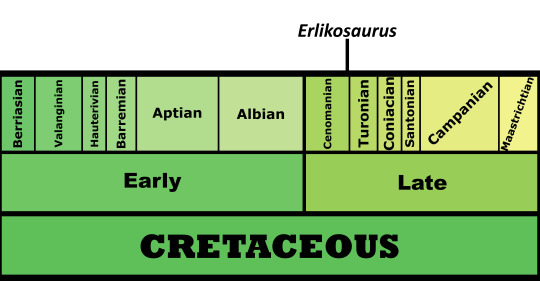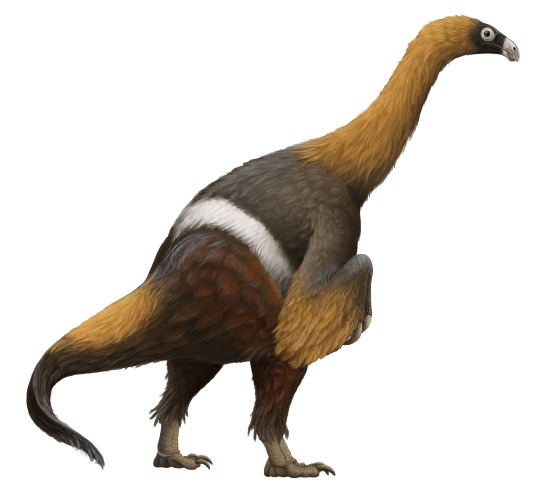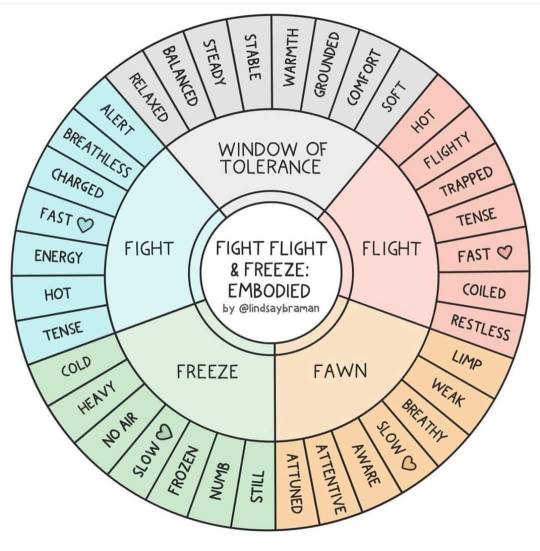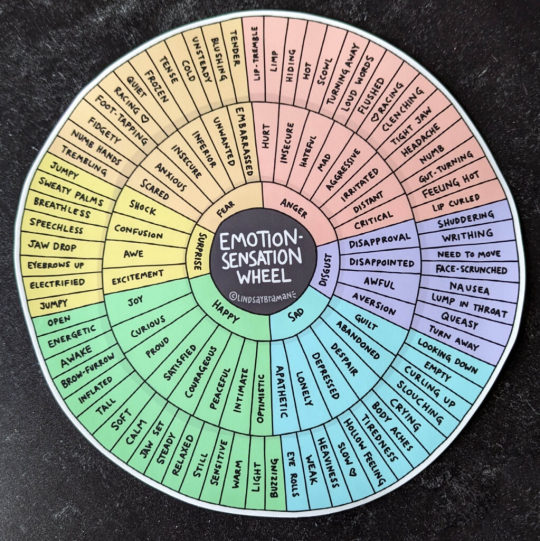#lindsay braman
Text

This graphic is so useful, I just wish it was easier to read
1 note
·
View note
Photo

(via Caution: Art May Cause You to Feel | Magazine | MoMA)
0 notes
Text
My visually formatted SUD scale is a helpful way to communicate internal feelings because it gives both sides a starting point for understanding. Scales like the SUDS help providers and patients speak the same language when they talk about internal experiences. People who are in therapy can use these scales to see how things are going. They can also use them to help them understand and identify their own experiences. Through the use of SUD scales, providers and patients can build a relationship built on trust and clear communication.
lindsay braman
0 notes
Text
Emotion Sensation Feeling Wheel Handout by Lindsay Braman - LindsayBraman.com
#
0 notes
Text
The SUD scale - or the Subjective Units of Distress Scale - is a way to measure how someone is feeling inside. It has previously been used in medical offices and has now become a tool used by therapists.
Lindsay Braman
0 notes
Text
Week 11: Light from Tate exhibition

We had the chance to visit the "Light from Tate" exhibition today at Auckland city gallery, and I was impressed by this piece of art "Stardust Particles", 2014 by Olafur Eliasson. It was the last piece of our visit, an impressive ending to an inspired exhibition celebrating light's role in art history.
"Stardust Particles" is a hanging sculpture that changes appearance depending on the lighting conditions and the viewer's position; the artwork changes appearance as the panes of partially reflective filter glass catch the light and reflect the surroundings. I resonate with this artwork because it portrays the importance of how the art looks and how it makes you feel. This piece fosters the feeling of relaxation, calmness, creativity, and inspiration. The play with light and the crystalline structure evokes the form of a greatly enlarged exploded star. Different dimensions help us acknowledge our perspective on the piece; it was stunning and made with care and detail. Lindsay Braman, Musem of Modern Art's (Moma) writer, once wrote, "When we view art with mindful presence, it can be a universally emotional experience". I can feel that when viewing this artwork. It brings a nostalgic feeling, yet calm and playful in the direction of the light reflecting on the surroundings.
Overall a genuinely inspiring and intriguing experience at the exhibition. I saw the evolution of how art used light as the main element of portraying the media and the art industry during different periods. Getting to see word famous artist artwork was also honoured. The exhibition taught me about the exact process of each piece of art. I'm inspired to create art with the right ethic and intention to focus on creating a meaningful and authentic experience for my viewers and target audience.
0 notes
Text

I love my space
(Poster by Lindsay Braman)
3 notes
·
View notes
Text
instagram
1 note
·
View note
Text
CAUTION: ART may cause you to feel...

0 notes
Text
Erlikosaurus andrewsi

By Ripley Cook
Etymology: Demon-King Reptile
First Described By: Perle, 1980
Classification: Dinosauromorpha, Dinosauriformes, Dracohors, Dinosauria, Saurischia, Eusaurischia, Theropoda, Neotheropoda, Averostra, Tetanurae, Orionides, Avetheropoda, Coelurosauria, Tyrannoraptora, Maniraptoromorpha, Maniraptoriformes, Maniraptora, Therizinosauria, THerizinosauridea, Therizinosauridae
Status: Extinct
Time and Place: About 90 million years ago, in the Turonian of the Late Cretaceous


Erlikosaurus is found in the Bayan Shireh Formation in Dornogovi, Mongolia

Physical Description: Erlikosaurus was a kind of Therizinosaur, the very bulky feathered dinosaurs with long, pointed claws extending from their hands. They’re weird in other ways, too - they have backward-facing hip bones like those of birds and Ornithischians, and giant pot-bellies to let them digest large amounts of plant material. As such, they stood up almost as vertical as people do - rather than horizontally like… all other dinosaurs. Erlikosaurus had a long neck, a squat body, short legs and a short tail; while its arms were normal length, it also had very long curved claws, like other therizinosaurs. It had very large and long nostrils for a therizinosaur, and a very high number of teeth compared to its relatives. Interestingly enough, therizinosaurs like Erlikosaurus also had swollen, pneumatized braincases, which allowed them to be lighter weight and potentially cool off quicker. Erlikosaurus also, unlike other Therizinosaurs, ahd long and slender claws on its feet. It may have been around six meters long. Like other therizinosaurs, it would have been covered with feathers all over its body, and potentially had very primitive long feathers on its arms like wings.
Diet: Erlikosaurus, like other therizinosaurs, was an herbivore.

By Jack Wood
Behavior: Erlikosaurus is a fascinating dinosaur behavior-wise because we actually have a decent number of scans of its brain, which may teach us aspects of its behavior. Erlikosaurus had a very well developed sense of smell, hearing, and balanced, which means that it retained a lot of the traits of carnivorous theropods - and probably used them to its advantage as an herbivore. It also probably was able to sense oncoming predators well and have complex social behavior. The range of its mouth, however, was narrower than that of its close carnivorous relatives - indicating that herbivorous dinosaurs, much like herbivorous mammals, had smaller mouth gapes than carnivores. With complicated social behavior, long claws, and good senses, Erlikosaurus would have been incredibly paranoid - and dangerous - ready to fend off anyone that would have threatened their family groups with those long scythe claws. As a social dinosaur, Erlikosaurus would have probably taken care of its young, and been warm blooded. The scythe claws, when not used in defense, would have been helpful in gathering plants down from the trees, much like with sloths today.
Ecosystem: The Bayan Shireh Environment was one of many such ecosystems found in the mid to late Cretaceous, showcasing a wide variety of animals that were almost - but not quite - like their latest Cretaceous counterparts. Here was a braided river environment, going through season wet and dry seasons as the mud and sand interchanged from one another leading to a variety of rock types and depositional environments. There were many water plants and flowering plants lining the shores, giving it a lush and green feel for at least part of the year - and giving Erlikosaurus something to eat! There were also fish, molluscs, the mammal Tsagandelta, and turtles making frequent appearances in the environment. Unnamed crocodylian relatives and Azhdarchid pterosaurs were present, but most of the charismatic animals present were other dinosaurs. Erlikosaurus wasn’t the only Therizinosaur, and also lived with Segnosaurus and Enigmosaurus. The very large, weird, and lopsided sauropod Erketu graced the treetops, slowly foraging on food, while the much smaller Ornithomimosaur Garudimimus scurried about between them all. Ankylosaurs went absolutely wild here, represented by Talarurus, Maleevus, and Tsagantegia. There were two small bipedal Ceratopsians, Graciliceratops and Microceratus, and the early hadrosauroid Gobihadros. There was also a mystery dinosaur, Amtosaurus, which has no affinity beyond “Ornithischian” at this point in time. As for predators, there was the very large raptor Achillobator and the small tyrannosaur Alectrosaurus - both similar in size to one another, and both giant dangers to the roaming herds of Erlikosaurus!

By Scott Reid
Other: Erlikosaurus was a very advanced therizinosaur, similar to later members of the group like Therizinosaurus rather than Early Cretaceous varieties. As such, it shows that the more classic therizinosaur body shape was around by the “mid” Cretaceous. In addition, it may or may not be the same animal as the other therizinosaurs found in its home - more research is needed to determine as such.
~ By Meig Dickson
Sources Under the Cut
Averianov, A. O. 2007. Theropod dinosaurs from Late Cretaceous deposits in the northeastern Aral Sea region, Kazakhstan. Cretaceous Research 28:532-544
Barsbold, R., and A. Perle. 1980. Segnosauria, a new infraorder of carnivorous dinosaurs. Acta Palaeontologica Polonica 25(2):187-195
Barsbold, R. 1981. Bezzubyye khishchnyye dinozavry Mongolii [Toothless carnivorous dinosaurs of Mongolia]. Sovmestnaia Sovetsko-Mongol’skaia Paleontologicheskaia Ekspeditsiia Trudy 15:28-39
Barsbold, R. 1983. Khishchnye dinosavry mela Mongoliy [Carnivorous dinosaurs from the Cretaceous of Mongolia]. Transactions of the Joint Soviet-Mongolian Paleontological Expedition 19:1-117
Barsbold, R. 1997. Mongolian dinosaurs. In P. J. Currie & K. Padian (ed.), Encyclopedia of Dinosaurs 447-450
Carroll, R. L. 1988. Vertebrate Paleontology and Evolution 1-698
Clark, J. M., T. Maryanska, and R. Barsbold. 2004. Therizinosauroidea. In D. B. Weishampel, P. Dodson, and H. Osmolska (eds.), The Dinosauria (second edition). University of California Press, Berkeley 151-164
Clark, J. M., M. A. Norell, L. M. Chiappe and A. Perle. 1995. The phylogenetic relationships of "segnosaurs" (Theropoda, Therizinosauridae). Journal of Vertebrate Paleontology 15(3, supl.):24A
Clark, J. M., A. Perle, and M. A. Norell. 1993. The skull of the segnosaurian dinosaur Erlikosaurus. Journal of Vertebrate Paleontology 13(3, suppl.):30A-31A
Clark, J. M., A. Perle, and M. A. Norell. 1994. The skull of Erlicosaurus andrewsi, a Late Cretaceous "segnosaur" (Theropoda: Therizinosauridae) from Mongolia. American Museum Novitates 3115:1-39
Currie, P. J. 1992. Saurischian dinosaurs of the Late Cretaceous of Asia and North America. In N. J. Mateer, P.-j. Chen (eds.), Aspects of Nonmarine Cretaceous Geology. China Ocean Press, Beijing 237-249
Currie, P. J., and D. A. Eberth. 1993. Palaeontology, sedimentology and palaeoecology of the Iren Dabasu Formation (Upper Cretaceous), Inner Mongolia, People's Republic of China. Cretaceous Research 14:127-144
Currie, P. J. 2000. Theropods from the Cretaceous of Mongolia. In M. J. Benton, M. A. Shishkin, D. M. Unwin, & E N. Kurichkin (eds.), The Age of Dinosaurs in Russia and Mongolia 434-455
Danilov, I. G. 1999. A new linholmemydid genus (Testudines: Lindholmemydidae) from the mid-Cretaceous of Uzbekistan. Russian Journal of Herpetology 6(1):63-71
Eberth, D. A., P. J. Currie, D. B. Brinkman, M. J. Ryan, D. R. Braman, J. D. Gardner, V. D. Lam, D. N. Spivak, and A. G. Neuman. 2001. Alberta's dinosaurs and other fossil vertebrates: Judith River and Edmonton groups (Campanian-Maastrichtian). In C. L. Hill (ed), Society of Vertebrate Paleontology, 61st Annual Meeting, Bozeman. Guidebook for the Field Trips: Mesozoic and Cenozoic Paleontology in the Western Plains and Rocky Mountains, Museum of the Rockies Occasional Paper 3:49-75
"Erlikosaurus." In: Dodson, Peter & Britt, Brooks & Carpenter, Kenneth & Forster, Catherine A. & Gillette, David D. & Norell, Mark A. & Olshevsky, George & Parrish, J. Michael & Weishampel, David B. The Age of Dinosaurs. Publications International, LTD. p. 142.
Gianechini, F. A., P. J. Makovicky, and S. Apesteguía. 2011. The teeth of the unenlagiine theropod Buitreraptor from the Cretaceous of Patagonia, Argentina, and the unusual dentition of the Gondwanan dromaeosaurids. Acta Palaeontologica Polonica 56(2):279-290
Hendrickx, C., and O. Mateus. 2014. Abelisauridae (Dinosauria: Theropoda) from the Late Jurassic of Portugal and dentition-based phylogeny as a contribution for the indentification of isolated theropod teeth. Zootaxa 3759(1):1-74
Hicks, J.F., Brinkman, D.L., Nichols, D.J., and Watabe, M. (1999). "Paleomagnetic and palynological analyses of Albian to Santonian strata at Bayn Shireh, Burkhant, and Khuren Dukh, eastern Gobi Desert, Mongolia." Cretaceous Research, 20(6): 829-850.
Jerzykiewicz, T. and Russell, D.A. (1991). "Late Mesozoic stratigraphy and vertebrates of the Gobi Basin." Cretaceous Research, 12(4): 345-377.
Kirkland, J. I., D. K. Smith, and D. G. Wolfe. 2005. Holotype braincase of Nothronychus mckinleyi Kirkland and Wolfe 2001 (Theropoda; Therizinosauridae) from the Upper Cretaceous (Turonian) of west-central New Mexico. In K. Carpenter (ed.), The Carnivorous Dinosaurs. Indiana University Press, Bloomington 87-96
Lautenschlager, Stephan; Rayfield, Emily J.; Altangerel Perle; Zanno, Lindsay E.; Witmer, Lawrence M. (2012). "The Endocranial Anatomy of Therizinosauria and Its Implications for Sensory and Cognitive Function". PLoS ONE. 7 (12): e52289.
Lautenschlager, Stephan (November 4, 2015). "Estimating cranial musculoskeletal constraints in theropod dinosaurs". Royal Society Open Science. 2 (11): 150495.
Li, D., C. Peng, H. You, M. C. Lamanna, J. D. Harris, K. J. Lacovara, and J. Zhang. 2007. A large therizinosauroid (Dinosauria: Theropoda) from the Early Cretaceous of northwestern China. Acta Geologica Sinica 81(4):539-549
Mader, B. J., and R. L. Bradley. 1989. A redescription and revised diagnosis of the syntypes of the Mongolian tyrannosaur Alectrosaurus olseni. Journal of Vertebrate Paleontology 9(1):41-55
Makovicky, P. J., and M. A. Norell. 1998. A partial ornithomimid braincase from Ukhaa Tolgod (Upper Cretaceous, Mongolia). American Museum Novitates 3247:1-16
Nessov, L. A. 1995. Dinozavri severnoi Yevrazii: Novye dannye o sostave kompleksov, ekologii i paleobiogeografii [Dinosaurs of northern Eurasia: new data about assemblages, ecology, and paleobiogeography]. Institute for Scientific Research on the Earth's Crust, St. Petersburg State University, St. Petersburg 1-156
Paul, G. S. 1984. The segnosaurian dinosaurs: relics of the prosauropod-ornithischian transition?. Journal of Vertebrate Paleontology 4(4):507-515
Perle, A. 1977. O pervoy nakhodke Alektrozavra (Tyrannosauridae, Theropoda) iz pozdnego Mela Mongolii [On the first discovery of Alectrosaurus (Tyrannosauridae, Theropoda) in the Late Cretaceous of Mongolia]. Shinzhlekh Ukhaany Akademi Geologiin Khureelen 3(3):104-113
Perle, A. 1981. Noviy segnozavrid iz verchnego mela Mongolii [A new segnosaurid from Mongolia]. Trudy - Sovmestnaya Sovetsko-Mongol'skaya Paleontologicheskaya Ekspeditsiya 15:50-59
Pu, H., Y. Kobayashi, J. Lu, Y. Wu, H. Chang, J. Zhang, and S. Jia. 2013. An unusual basal therizinosaur with an ornithischian dental arrangement from northeastern China. PLoS ONE 8(5):e63423
Qian, M.-p., Z.-y. Zhang, Y. Jiang, Y.-g. Jiang, Y.-j. Zhang, R. Chen, and G.-f. Xing. 2012. [Cretaceous therizinosaurs in Zhejiang of eastern China]. Journal of Geology 36(4):337-348
Rauhut, O. W. M. 2003. The interrelationships and evolution of basal theropod dinosaurs. Special Papers in Palaeontology 69:1-213
Russell, D. A. 1997. Therizinosauria. In P. J. Currie & K. Padian (ed.), Encyclopedia of Dinosaurs 729-730
Russell, D. A., and Z.-M. Dong. 1994. The affinities of a new theropod from the Alxa Desert, Inner Mongolia, People's Republic of China. Canadian Journal of Earth Sciences 30(10-11):2107-2127
Senter, P., J. I. Kirkland, and D. D. DeBlieux. 2012. Martharaptor greenriverensis, a new theropod dinosaur from the Lower Cretaceous of Utah. PLoS ONE 7(8):e43911:1-12
Sereno, P. C. 1998. A rationale for phylogenetic definitions, with application to the higher-level taxonomy of Dinosauria. Neues Jahrbuch für Geologie und Paläontologie, Abhandlungen 210(1):41-83
Sues, H.-D. 1997. On Chirostenotes, a Late Cretaceous oviraptorosaur (Dinosauria: Theropoda) from western North America. Journal of Vertebrate Paleontology 17(4):698-716
Sukhanov, V. B., and P. Narmandakh. 1975. Cherepakhi gruppy Basilemys (Chelonia, Dermatemydidae) v Asiy [New turtles from the Basilemys group (Chelonia, Dermatemydidae) in Asia]. In N. Kramarenko, B. Luwsandansan, Yu. Voronin, R. Barsbold, A. Rozhdestvensky (eds.), Iskopaemaya Fauna I Flora Mongolii [Fossil Flora and Fauna of Mongolia]. Sovmestnaya Sovetsko-Mongol'skaya Paleontologicheskaya Ekspeditsiya, Trudy [The Joint Soviet-Mongolian Paleontological Expedition, Transactions] 2:94-101
Tsuihiji, T., M. Watabe, R. Barsbold and K. Tsogtbaatar. 2015. A gigantic caenagnathid oviraptorosaurian (Dinosauria: Theropoda) from the Upper Cretaceous of the Gobi Desert, Mongolia. Cretaceous Research 56(1):60-65
Turner, A. H., S. H. Hwang, and M. A. Norell. 2007. A small derived theropod from Öösh, Early Cretaceous, Baykhangor Mongolia. American Museum Novitates 3557:1-27
Weishampel, David B.; Dodson, Peter; and Osmólska, Halszka (eds.): The Dinosauria, 2nd, Berkeley: University of California Press. 861 pp.
Xu, X., Z.-H. Zhang, P. C. Sereno, X.-J. Zhao, X.-W. Kuang, J. Han, and L. Tan. 2002. A new therizinosauroid (Dinosauria, Theropoda) from the Upper Cretaceous Iren Dabasu Formation of Nei Mongol. Vertebrata PalAsiatica 40(3):228-240
Varricchio, D. J. 1997. Troodontidae. In P. J. Currie & K. Padian (ed.), Encyclopedia of Dinosaurs 749-754
Zanno, L. 2004. The pectoral girdle and forelimb of a primitive therizinosauroid (Theropoda: Maniraptora): new information on the phylogenetics and evolution of therizinosaurs. Journal of Vertebrate Paleontology 24(3, suppl.):134A
Zanno, L. E. 2006. The pectoral girdle and forelimb of the primitive therizinosauroid Falcarius utahensis (Theropoda, Maniraptora): analyzing evolutionary trends within Therizinosauroidea. Journal of Vertebrate Paleontology 26(3):636-650
Zanno, Lindsay E. (2010). "A taxonomic and phylogenetic re-evaluation of Therizinosauria (Dinosauria: Maniraptora)". Journal of Systematic Palaeontology. 8 (4): 503–543.
Zhang, X.-H., X. Xu, X.-J. Zhao, P. C. Sereno, X.-W. Kuang and L. Tan. 2001. A long-necked therizinosauroid dinosaur from the Upper Cretaceous Iren Dabasu Formation of Nei Mongol, People's Republic of China. Vertebrata PalAsiatica 39(4):282-290
#erlikosaurus#erlikosaurus andrewsi#dinosaur#therizinosaur#feathered dinosaurs#factfile#palaeoblr#feathered dinosaur#maniraptoran#Cretaceous#Eurasia#Herbivore#Theropod Thursday#paleontology#prehistory#prehistoric life#dinosaurs#biology#a dinosaur a day#a-dinosaur-a-day#dinosaur of the day#dinosaur-of-the-day#science#nature
324 notes
·
View notes
Text
Oooooooooooooohhhhhhhh
"HOW THE EMOTION-SENSATION WHEEL IS DIFFERENT:
The two inner rings of this wheel are emotions, the outside ring contains descriptions of the actual physical sensations that may accompany that emotion, described in concrete sensory language. (Language intended to be more accessible for people who are very literal or who are on the ASD spectrum)"
0 notes
Photo

“Kids who grow up in families where emotional needs are not validated and met often develop a deep sense of internal shame for having needs at all. Over time, to cope, many of these kids become adults with little or no capacity to experience their emotions. @hilaryjacobshendel's work explores how chronic shame and #alexithymia is often misdiagnosed as depression and how, through therapy that includes help discovering the physical cues of emotions that remain in the body, people can rediscover their emotional experience, receive validation of their unmet emotional needs, and decrease shame.“ -Thank you to Lindsay Braman for this gorgeous graphic and post. . Click on link to read Brian’s story about neglect and recovery in “It’s Not Always Depression, Sometimes It’s Shame.” https://www.hilaryjacobshendel.com/its-not-always-depression-sometimes-its- 🔻 #emotion #education #itsnotalwaysdepression #thechangetriangle #treatmentresistantdepression #wellness #wellbeing #mentalhealth #books #bookstagram #traumainformed #emotionalhealth #AEDP #therapyworks #therapy #emotionalintelligence #depression #parenting #attachmentparenting #neglect #psychoeducation https://www.instagram.com/p/B8F0qtahiub/?igshid=12r8fc9wl6wwr
#alexithymia#emotion#education#itsnotalwaysdepression#thechangetriangle#treatmentresistantdepression#wellness#wellbeing#mentalhealth#books#bookstagram#traumainformed#emotionalhealth#aedp#therapyworks#therapy#emotionalintelligence#depression#parenting#attachmentparenting#neglect#psychoeducation
1 note
·
View note
Link
Therapist and artist Lindsay Braman has been creating some beautiful and wonderfully helpful materials to support mental health during the stress of the current situation. Materials for adults and kids alike.
0 notes

